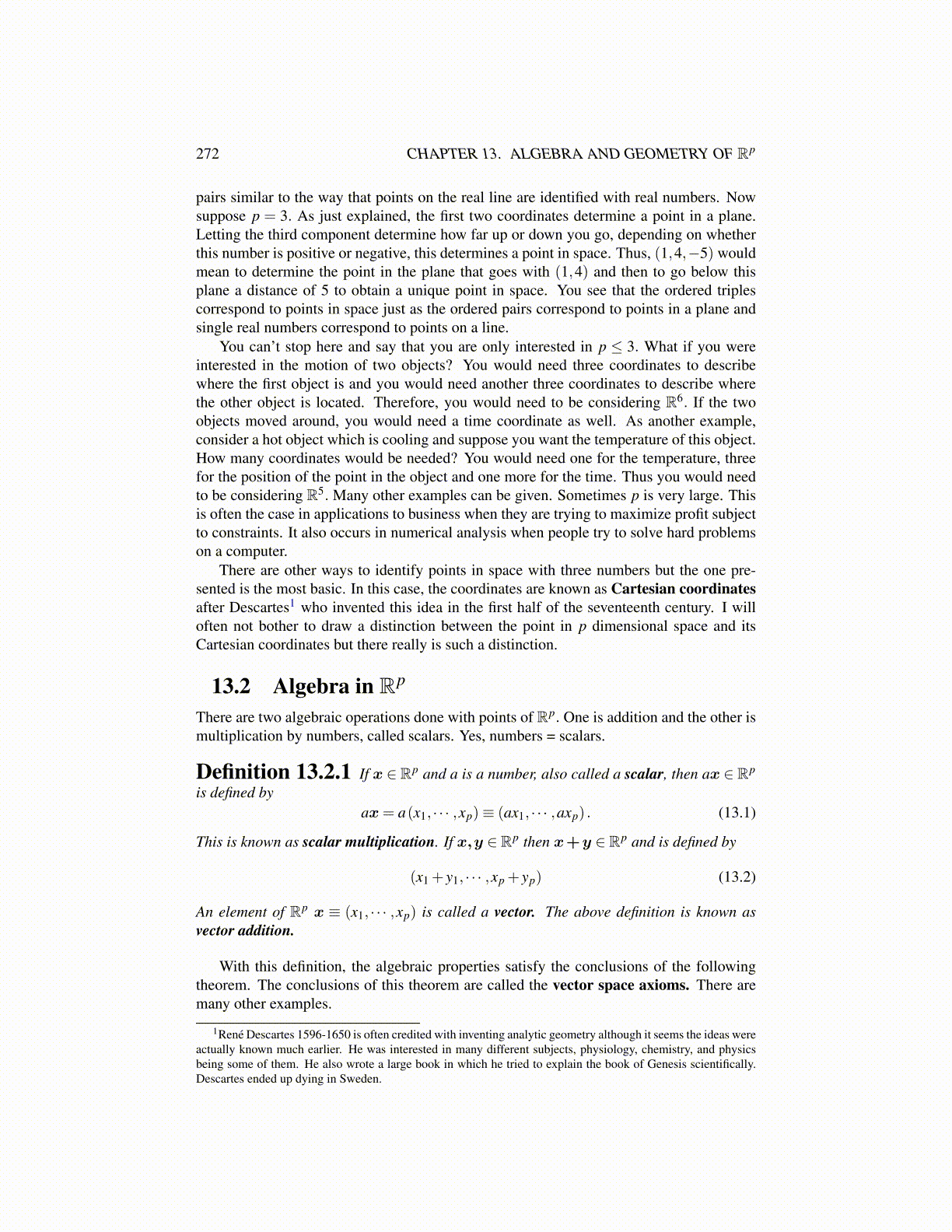
272 CHAPTER 13. ALGEBRA AND GEOMETRY OF Rp
pairs similar to the way that points on the real line are identified with real numbers. Nowsuppose p = 3. As just explained, the first two coordinates determine a point in a plane.Letting the third component determine how far up or down you go, depending on whetherthis number is positive or negative, this determines a point in space. Thus, (1,4,−5) wouldmean to determine the point in the plane that goes with (1,4) and then to go below thisplane a distance of 5 to obtain a unique point in space. You see that the ordered triplescorrespond to points in space just as the ordered pairs correspond to points in a plane andsingle real numbers correspond to points on a line.
You can’t stop here and say that you are only interested in p ≤ 3. What if you wereinterested in the motion of two objects? You would need three coordinates to describewhere the first object is and you would need another three coordinates to describe wherethe other object is located. Therefore, you would need to be considering R6. If the twoobjects moved around, you would need a time coordinate as well. As another example,consider a hot object which is cooling and suppose you want the temperature of this object.How many coordinates would be needed? You would need one for the temperature, threefor the position of the point in the object and one more for the time. Thus you would needto be considering R5. Many other examples can be given. Sometimes p is very large. Thisis often the case in applications to business when they are trying to maximize profit subjectto constraints. It also occurs in numerical analysis when people try to solve hard problemson a computer.
There are other ways to identify points in space with three numbers but the one pre-sented is the most basic. In this case, the coordinates are known as Cartesian coordinatesafter Descartes1 who invented this idea in the first half of the seventeenth century. I willoften not bother to draw a distinction between the point in p dimensional space and itsCartesian coordinates but there really is such a distinction.
13.2 Algebra in Rp
There are two algebraic operations done with points of Rp. One is addition and the other ismultiplication by numbers, called scalars. Yes, numbers = scalars.
Definition 13.2.1 If x ∈ Rp and a is a number, also called a scalar, then ax ∈ Rp
is defined byax= a(x1, · · · ,xp)≡ (ax1, · · · ,axp) . (13.1)
This is known as scalar multiplication. If x,y ∈ Rp then x+y ∈ Rp and is defined by
(x1 + y1, · · · ,xp + yp) (13.2)
An element of Rp x ≡ (x1, · · · ,xp) is called a vector. The above definition is known asvector addition.
With this definition, the algebraic properties satisfy the conclusions of the followingtheorem. The conclusions of this theorem are called the vector space axioms. There aremany other examples.
1René Descartes 1596-1650 is often credited with inventing analytic geometry although it seems the ideas wereactually known much earlier. He was interested in many different subjects, physiology, chemistry, and physicsbeing some of them. He also wrote a large book in which he tried to explain the book of Genesis scientifically.Descartes ended up dying in Sweden.